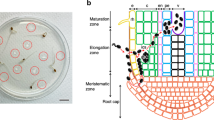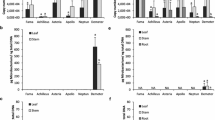Abstract
The population dynamics of Pectobacterium atrosepticum SCRI1043 (Pba) within tobacco plants was monitored from the time of inoculation until after long-term preservation of microorganisms in the remnants of dead plants. We found and characterised peculiar structures that totally occlude xylem vessels, which we have named bacterial emboli. Viable but non-culturable (VBN) Pba cells were identified in the remnants of dead plants, and the conditions for resuscitation of these VBN cells were established. Our investigation shows that dissociation of the integrated bacterial population during plant colonisation forms distinct subpopulations and cell morphotypes, which are likely to perform specific functions that ensure successful completion of the life cycle within the plant.







Similar content being viewed by others
References
Adams MJ, Lapwood DH (1983) The effect of Erwinia carotovora subsp. atroseptica (blackleg) on potato plants. II. Compensatory growth. Ann Appl Biol 103:79–85
Anetzberger C, Pirch T, Jung K (2009) Heterogeneity in quorum sensing-regulated bioluminescence of Vibrio harveyi. Mol Microbiol 73:267–277
Baccari C, Lindow SE (2011) Assessment of the process of movement of Xylella fastidiosa within susceptible and resistant grape cultivars. Phytopathol 101:77–84
Barnard AML, Bowden SD, Burr T, Coulthurst SJ, Monson RE, Salmond GPC (2007) Quorum sensing, virulence and secondary metabolite production in plant soft-rotting bacteria. Phil Trans R Soc B 362:1165–1183
Bell KS, Sebaihia M, Pritchard L, Holden MTG, Hyman LJ, Holeva MC, Thomson NR, Bentley SD, Churcher LJC, Mungall K, Atkin R, Bason N, Brooks K, Chillingworth T, Clark K, Doggett J, Fraser A, Hance Z, Hauser H, Jagels K, Moule S, Norbertczak H, Ormond D, Price C, Quail MA, Sanders M, Walker D, Whitehead S, Salmond GPC, Birch PRJ, Parkhill J, Toth IK (2004) Genome sequence of the enterobacterial phytopathogen Erwinia carotovora subsp. atroseptica and characterization of virulence factors. Microbiology 101:11105–11110
Boher B, Kpemoua K, Nicole M, Luisetti J, Geiger JP (1995) Ultrastructure of interactions between Cassava and Xanthomonas campestris pv. manihotis: cytochemistry of cellulose and pectin degradation in a susceptible. Phytopathol 85:777–788
Christensen L, Moser C, Jensen P, Rasmussen T, Christophersen L, Kjelleberg S, Kumar N, Hoiby N, Givskov M, Bjarnsholt T (2007) Impact of Pseudomonas aeruginosa quorum sensing on biofilm persistence in an in vivo intraperitoneal foreign-body infection model. Microbiol 153:2312–2320
Collmer A, Keen NT (1986) The role of pectic enzymes in plant pathogenesis. Ann Rev Phytopathol 24:383–409
Cui Y, Madi L, Mukherjee A, Dumenyo CK, Chatterjee AK (1996) The RsmA- mutants of Erwinia carotovora subsp. carotovora strain Ecc71 overexpress hrpN Ecc and elicit a hypersensitive reaction-like response in tobacco leaves. MPMI 9:565–573
Czajkowski R, de Boer WJ, van Veen JA, van der Wolf JM (2010) Downward vascular translocation of a green fluorescent protein-tagged strain of Dickeya sp. (Biovar 3) from stem and leaf inoculation sites on potato. Phytopathol 100:1128–1137
Danhorn T, Fuqua C (2007) Biofilm formation by plant-associated bacteria. Annu Rev Microbiol 61:401–422
Day AP, Oliver O (2004) Changes in membrane fatty acid composition during entry of Vibrio vulnificus into the viable but nonculturable state. J Microbiol 42:69–73
Duda VI, Pronin SV, El'-Registan GI, Kaprel'iants AS, Mitiushina LL (1982) Formation of resting refractile cells in Bacillus cereus as affected by an autoregulatory factor. Mikrobiologiia 51:77–81
El'-Registan GI, Muliukin AL, Nikolaev IA, Suzina NE, Gal'chenko VF, Duda VI (2006) Adaptive functions of extracellular autoregulators of microorganisms. Mikrobiologiia 75:446–456
El'-Registan GI, Tsyshnatii GV, Duzha MV, Pronin SV, Mitiushina LL (1980) Regulation of growth and of Pseudomonas carboxydoflava by specific endogenous factors. Mikrobiologiia 49:561–565
Ger MJ, Chen CH, Hwang SY, Huang HE, Podile AR, Dayakar BV, Feng TY (2002) Constitutive expression of hrap gene in transgenic tobacco plant enhances resistance against virulent bacterial pathogens by induction of a hypersensitive response. MPMI 15:764–773
Gorshkov V, Petrova O, Gogoleva N, Gogolev Y (2010) Cell-to-cell communication in the populations of enterobacterium Erwinia carotovora ssp. atroseptica SCRI1043 during adaptation to stress conditions. FEMS Immunol Med Microbiol 59:378–385
Gorshkov VY, Petrova OE, Mukhametshina NE, Ageeva MV, Mulyukin AL, Gogolev YV (2009) Formation of “nonculturable” dormant forms of the phytopathogenic enterobacterium Erwinia carotovora. Mikrobiologiia 78:585–592
Grey B, Steck T (2001) The viable but nonculturable state of Ralstonia solanacearum may be involved in long-term survival and plant infection. Appl Environ Microbiol 7:3866–3872
Harris RI, Lapwood DH (1978) The spread of Erwinia carotovora var. atroseptica (blackleg) from degenerating seed to progeny tubers in soil. Potato Res 21:285–294
Helias V, Andrivon D, Jouan B (2000a) Development of symptoms caused by Erwinia carotovora ssp. atroseptica under field conditions and their effects on the yield of individual potato plants. Plant Pathol 49:23–32
Helias V, Andrivon D, Jouan B (2000b) Internal colonization pathways of potato plants by Erwinia carotovora ssp. atroseptica. Plant Pathol 49:33–42
Huang P-Y, Huang J-S, Goodman RN (1975) Resistance mechanisms of apple shoots to an avirulent strain of Erwinia amylovora. Physiol Plant Pathol 6:283–287
Kim H-S, Thammarat P, Lommel SA, Hogan CS, Charkowski AO (2011) Pectobacterium carotovorum elicits plant cell death with DspE/F but the P. carotovorum DspE does not suppress callose or induce expression of plant genes early in plant–microbe interactions. MPMI 24:773–786
Kussell E, Leibler S (2005) Phenotypic diversity, population growth, and information in fluctuating environments. Science 309:2075–2078
Lapwood DH, Harris RI (1982) The spread of Erwinia carotovora subsp. atroseptica and subsp. carotovora from stem lesions and degenerating seed tubers to progeny tubers in soil. Potato Res 25:41–50
Lidstrom M, Konopka M (2010) The role of physiological heterogeneity in microbial population behavior. Nature Chem Biol 6:705–712
Lin K, Husmeier D, Dondelinger F, Mayer CD, Liu H, Prichard L, Salmond GPC, Toth IK, Birch PRJ (2010) Reverse engineering gene regulatory networks related to quorum sensing in the plant pathogen Pectobacterium atrosepticum. Methods Mol Biol 673:253–81
Liu H, Coulthurst SJ, Pritchard L, Hedley PE, Ravensdale M, Humphris S, Burr T, Takle G, Brurberg M-B, Birch PRJ, Salmond GPC, Toth IK (2008) Quorum sensing coordinates brute force and stealth modes of infection in the plant pathogen Pectobacterium atrosepticum. PLoS Pathogens 4:1–11
Liu Y, Jiang G, Cui Y, Mukherjee A, Ma W, Chatterjee A (1999) kdgREcc negatively regulates genes for pectinases, cellulase, protease, harpinEcc, and a global RNA regulator in Erwinia carotovora subsp. carotovora. J Bacteriol 181:2411–2422
Mäe A, Montesano M, Koiv V, Palva ET (2001) Transgenic plants producing the bacterial pheromone N-Acyl-homoserine lactone exhibit enhanced resistance to the bacterial phytopathogen Erwinia carotovora. MPMI 14:1035–1042
Manos J, Arthur J, Rose B, Bell S, Tingpej P, Hu H, Webb J, Kjelleberg S, Gorrell M, Bye P, Harbour C (2009) Gene expression characteristics of a cystic fibrosis epidemic strain of Pseudomonas aeruginosa during biofilm and planktonic growth. FEMS Microbiol Lett 292:107–114
Mattinen L, Nissinen R, Riipi T, Kalkkinen N, Pirhonen M (2007) Host-extract induced changes in the secretome of the plant pathogenic bacterium Pectobacterium atrosepticum. Proteomics 7:3527–3537
Matz M, McDougald D, Moreno A, Yung P, Yildiz F, Kjelleberg S (2005) Biofilm formation and phenotypic variation enhance predation-driven persistence of Vibrio cholerae. PNAS 102:16819–16824
Misas-Villamil JC, Kolodziejek I, van der Hoorn RAL (2011) Pseudomonas syringae colonizes distant tissues in Nicotiana benthamiana through xylem vessels. Plant J 67:774–782
Muliukin AL, Lusta RF, Griaznova MN, Kozlova AN, Duda VI, El'-Registan GI (1996) Formation of a resting form of Bacillus cereus and Micrococcus luteus. Mikrobiologiia 65:782–789
Muliukin AL, Suzina NE, Duda VI, El'-Registan GI (2008) Structural and physiological diversity among cystlike resting cells of bacteria of the genus Pseudomonas. Mikrobiologiia 77:512–23
Murashige T, Skoog F (1962) A revised medium for rapid growth and bio assays with tobacco tissue cultures. Physiol Plant 15:473–497
Oliver J (1995) The viable but non-culturable state in the human pathogen Vibrio vulnificus. FEMS Microbiol Lett 133:203–208
Ordax М, Biosca EG, Wimalajeewa SC, López MM, Marco-Noales E (2009) Survival of Erwinia amylovora in mature apple fruit calyces through the viable but nonculturable (VBNC) state. J Appl Microbiol 107:106–116
Perez-Mendoza D, Coulthurst SJ, Sanjuan J, Salmond GPC (2011) N-Acetylglucosamine-dependent biofilm formation in Pectobacterium atrosepticum is cryptic and activated by elevated c-di-GMP levels. Microbiology 157:3340–3348
Perombelon MCM, Kelman A (1980) Ecology of the soft rot Erwinias. Annu Rev Phytopathol 18:361–387
Purcell AH, Hopkins DL (1996) Fastidious xylem-limited bacterial plant pathogens. Annu Rev Phytopathol 34:131–151
Rahman I, Shahamat M, Chowdhury M, Colwell R (1996) Potential virulence of viable but nonculturable Shigella dysenteriae type I. Appl Environ Microbiol 62:4621–4626
Ramey B, Koutsoudis M, von Bodman S, Fuqua C (2004) Biofilm formation in plant–microbe associations. Curr Opin Microbiol 7:602–609
Reynolds ES (1963) The use of lead citrate at high pH as an electron opaque stain in electron microscopy. J Cell Biol 17:208–212
Roszak D, Grimes D, Colwell R (1984) Viable but nonrecoverable stage of Salmonella enteritidis in aquatic systems. Can J Microbiol 30:334–338
Sambrook J, Fritsch EF, Maniatis T (1989) Molecular cloning: a Laboratory Manual, Second Edition. Cold Spring Harbor Press, Cold Spring Harbor, NY, p 1659
Stoodley L, Stoodley P (2009) Evolving concepts in biofilm infection. Cell Microbiol 11:1034–1043
Suzina NE, Muliukin AL, Kozlova AN, Shorokhova AP, Dmitriev VV, Barinova ES, Mokhova ON, El'-Registan GI, Duda VI (2004) Ultrastructure of resting cells of some non-spore-forming bacteria. Mikrobiologiia 73:516–529
Tang X, Hiao Y, Zhou JM (2006) Regulation of the type III secretion system in phytopathogenic bacteria. MPMI 19:1159–1166
Thiery JP (1967) Mise en evidence des polysaccharides sur coupes fines en microscopie electronique. J Microsc 6:987–1018
Wallis FM, Rijkenberg FHJ, Joubert JJ, Martin MM (1973) Ultrastructural histopathology of cabbage leaves infected with Xanthomonas campestris. Physiol Plant Pathol 3:371–378
Zimnoch-Guzowska E, Lebecka R, Pietrak J (1999) Soft rot and blackleg reactions in diploid potato hybrids inoculated with Erwinia spp. Amer J Potato Res 76:199–207
Acknowledgments
This study was supported in part by the Russian Foundation for Basic Research, research project nos. 12-04-31059-MOL_A and 11-04-02097-a and by a grant from the programme Leading Scientific Schools no. NSH-825.2012.4 (Supervisor A.N. Grechkin) and grant no. 14.740.11.1190 from the Federal Target Programme.
Conflict of interest
The authors declare that they have no conflict of interest.
Author information
Authors and Affiliations
Corresponding author
Additional information
Handling Editor: Friedrich W. Bentrup
Rights and permissions
About this article
Cite this article
Gorshkov, V., Daminova, A., Ageeva, M. et al. Dissociation of a population of Pectobacterium atrosepticum SCRI1043 in tobacco plants: formation of bacterial emboli and dormant cells. Protoplasma 251, 499–510 (2014). https://doi.org/10.1007/s00709-013-0546-3
Received:
Accepted:
Published:
Issue Date:
DOI: https://doi.org/10.1007/s00709-013-0546-3




